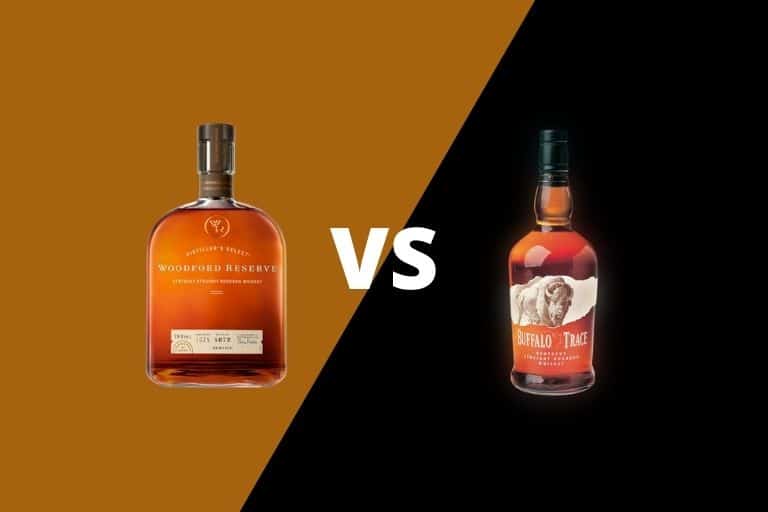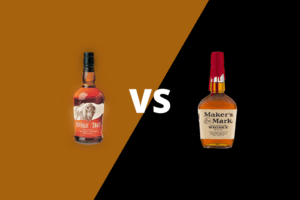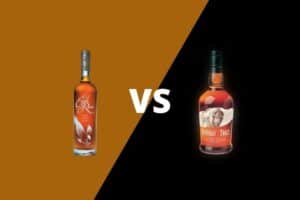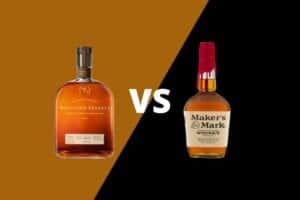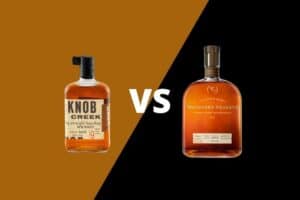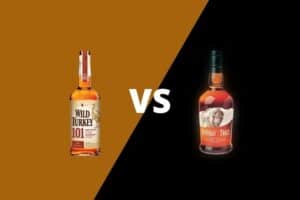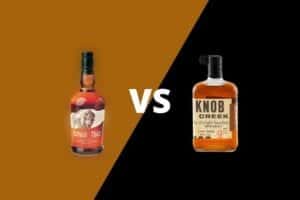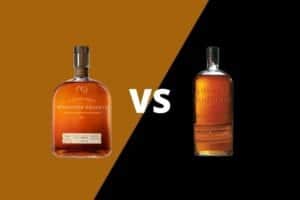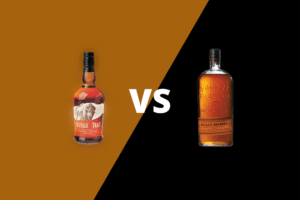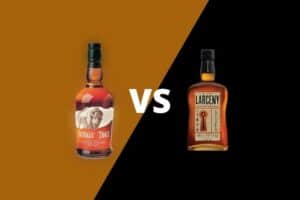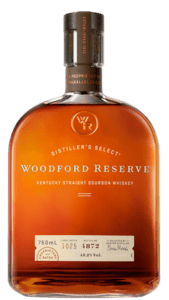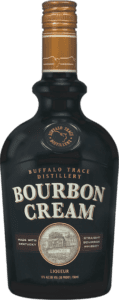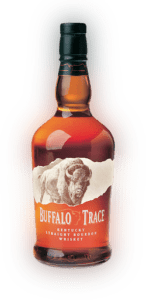Woodford Reserve and Buffalo Trace might not be the first two brand names you think to put side-by-side in a matchup.
They come from different price segments — Woodford Reserve is considered a premium brand, while Buffalo Trace’s price puts it squarely in the standard segment. But deciding between two whiskey selections solely on price can have its pratfalls. After all, there are a lot of awfully expensive distilled spirits out there, and not all of them are worth the investment.
So, where does that leave the curious whiskey drinker?
Although these brands inhabit different shelves in the liquor aisle, they may have more in common than you think. In this post, we’ll take a hard look at these brands to help you make an educated decision based on reason, value and your tongue — rather than your wallet alone.
Table of Contents
History
Our story revolves around two 19th-century distilleries whose histories are oddly parallel.
An impressive roster of prominent historical Kentucky Bourbon figures passed through the doors of these two distilleries, where countless innovations to the science of whiskey making have taken place. If we listed all of the fantastic brands crafted at the two sites over the decades, it might blow the average bourbon drinker’s mind.
1812 was a busy year. With war with the British as a backdrop, ground was broken on two sites in Kentucky that would help to shape the bourbon industry over the next two centuries.
That year, construction began at the site where today’s Buffalo Trace Distillery now stands. The area around Frankfurt, Kentucky, was already known for illicit distillation before the legal distillery owned by Harrison Blanton opened for business. In 1870 it was purchased by Edmund H. Taylor and named the Old Fire Copper Distillery — O.F.C. The distillery was operating as the George T. Stag Distillery when the Sazerac Company purchased the site in 1992. Sazerac renamed it the Buffalo Trace Distillery and launched the flagship bourbon with the same name later that decade.
The Woodford Reserve Distillery also has a history dating back to 1812. It was founded as the Old Oscar Pepper Distillery just north of Versailles, Kentucky. It later operated as the Labrot & Graham Distillery until Brown Forman purchased it in 1993. Brown Forman renamed it the Woodford Reserve Distillery and launched the bourbon by that name later in the decade.
Ownership
Buffalo Trace Bourbon is owned by the Sazerac Company, a distilled spirits producer based in New Orleans, Louisiana. Sazerac is known for the Rye whiskey brand and cocktail of the same name. The cocktail, by the way, is a registered trademark of Sazerac Company, Inc.
Woodford Reserve is owned by Brow-Forman, producer of Jack Daniel’s Tennessee Whiskey, considered the largest American whiskey producer in volume sales.
Mashbills
Woodford Reserve Master Distiller Chris Morris oversees ferments with 72 percent corn, 18 percent rye and 10 percent malted barley.
Over at Buffalo Trace, Master Distiller Harlen Wheatley keeps his grain recipe close to the vest. While the exact proportions have not been revealed, we do know that all bourbons are required to contain at least 51 percent corn. Buffalo Trace has a significant rye content based on flavor profile and uses malted barley in the mash bill.
Maturation
Both brands are labeled as Kentucky Straight Bourbon Whiskey, but neither has an age statement.
All Bourbon whiskey products are required by law to mature the spirit in new American charred oak barrels. Products labeled as ‘Straight Whiskey’ must be aged for a minimum of two years.
Brown-Forman owns its own cooperage, where they build barrels for Jack Daniel’s, Woodford Reserve and other brands owned by the spirits giant. Owning this piece of the supply chain allows for a level of control over the barrel-making process that other master distillers envy.
The char requirements set bourbon barrels apart from casks used to mature other alcoholic beverages like wine and beer. Wine casks are often toasted — think of baking a barrel in a large oven — but they are not exposed to direct, open flame.
One barrel detail whiskey makers find critical is the level of barrel char. To create char, the barrel is exposed to an open flame for a duration of time. The length of exposure correlates to a number on a scale from 1 to 5, indicating the thickness of the burnt layer of charred wood inside.
Most barrels are exposed for less than a minute, so mere seconds make a huge difference. No. 1 barrels resemble a winemaker’s toasted barrel, while a No. 5 is sometimes called ‘alligator char’ because of the ridge of deep burnt bumps that run down the inside of each barrel stave and resemble an alligator’s back.
The depth of the char layer plays an essential role in the maturation process. It acts as a natural charcoal filter as the spirit moves in and out of the wood as the temperature fluctuates over the seasons. When it gets hot, the liquid expands through the char and into the red layer — where tannins and flavor compounds like vanillin are imparted to the spirit. And when it gets cold, the liquid constricts through that same char layer. This movement through the charcoal works over time to filter the spirit of unwanted congeners, methyl alcohols, fusel oils and other impurities that make it through the distillation process.
Distillation & Production
Buffalo Trace Bourbon is distilled and matured at the Buffalo Trace Distillery in Frankfort, Kentucky. It is produced on a large column still using modern high-volume techniques. Column distillation allows distillers to precisely control the clear distillate’s strength and quality as it comes off the still. With a reflux column, whiskey makers can feed beer into the system and collect spirit with only one pass.
The Woodford Reserve Distillery hosts three large copper pot stills. These stills represent a traditional form of whiskey making prevalent in Kentucky before the invention of the column still in the mid-1800s. Copper pot distillation requires beer to run through two passes for the spirit to reach the strength required for whiskey — which is placed into the barrel at under 125-proof. As a result, more flavor compounds make it into the spirit, which can add complexity after being exposed to the maturation process in the barrel.
Woodford Reserve Distiller’s Select Bourbon — the most well-known and well-distributed brand expression — contains a portion of whiskey produced in the Woodford Reserve Distillery’s copper pots. To create each batch, barrels with this traditional method are combined with barrels filled with spirit off the large column stills at the Brown Forman Distillery in Shively, Kentucky.
Other Woodford Reserve brand extension and special release products are made exclusively with bourbon distilled on the distillery’s copper pot stills.
Price Point & Value
When comparing these two brands, it is important to remember they come from different category pricing segments. While the adage ‘you get what you pay for’ isn’t applied evenly in the whiskey business, the higher price point does allow for some additional expenditures in the production process.
Buffalo Trace costs about $27 for a 750mL bottle, which places the bottle in the standard pricing segment. It is bottled at 90-proof, or 45 percent alcohol by volume.
Woodford Reserve Bourbon is priced at about $39 for a 750mL bottle at 90.4-proof, or 45.2 percent ABV.
Tasting Notes
Buffalo Trace Bourbon
Appearance: In the glass, Buffalo Trace has a deep amber color, with nice legs at 90-proof.
Nose: Complex aroma, with notes of oaky wood barrel flavors, leather, tobacco and vanilla.
Tongue: Wide range of flavors. Bold spicy rye character with black pepper and walnut notes.
Finish: Spicy, earthy with lingering toffee and notes of cinnamon.
[Related: Complete Buffalo Trace Bourbon Review]
Woodford Reserve Distiller’s Select Bourbon
Appearance: In the glass, Woodford Reserve has the deep gold color of burnished copper. It has healthy legs at 90.4-proof.
Nose: New oak aromas of caramel and vanilla, with notes of almonds, toffee and dark chocolate.
Palate: Corn sweetness and a buttery mouthfeel, with flavors of almonds, walnuts, chocolate, cinnamon, vanilla and raisins.
Finish: Chocolate, vanilla, with lingering notes of leather and tobacco and a hint of smoke.
[Related: Complete Woodford Reserve Review]
Verdict…
This matchup might come down to how much you want to spend.
Buffalo Trace is a delicious bourbon — versatile enough for bourbon aficionado to enjoy neat, or on the rocks. But as a standard expression, it is an excellent choice for bar managers and craft cocktail mixologists looking for a bottle for high-end cocktails — one that delivers way more value than you might expect for the price.
As a premium-priced bottle of bourbon, Woodford Reserve offers a chance for the more seasoned bourbon drinker to trade-up and try a brand from a higher shelf. While its sticker price might be higher, the attention to detail and the traditional distillation practiced by the production staff also offer an excellent bang-for-buck. As a learning vehicle, it is one of the few nationally distributed bourbon brands that offer a chance to discover flavor characteristics associated with copper pot distillation.

